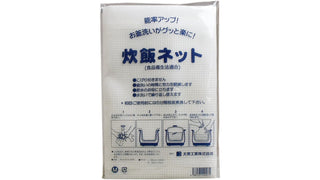Why You Need a Rice Net
Everybody who is into making Japanese food eventually has that unsettling day when they ask their Japanese friend about "the right way to make Japanese rice". They will tell you to "wash" the rice "a few times" and so you naturally try to ask about the exact number of times that it should be washed. Depending on the friend's mood on that particular day, their answer will range between the foreigner-friendly and decisive "five times" to the authentic nightmare difficulty game setting of "until the water becomes clear". After quietly realizing you had been doing it wrong the whole time, you start to worry if you had been eating "dirty rice" and wonder what kind of dangerous substances you may have consumed from only washing the rice... once... or perhaps... not at all! Fortunately, this "washing" is actually not to clean harmful dirt on the rice but rather just remove some of the starch. Japanese rice has that distinctive sticky quality that makes it enjoyable to eat with chopsticks but this also means especially out of the bag it contains much higher starch and protein than other kinds of rice. So if you don't wash it off then it will be too sticky and excessively chewy. Now your questions might return to asking, "how many times does it take to make the water... clear?". But this number would really depend on an infinite amount of variables surrounding the manufacturer of the rice and conditions of where it was grown resulting in a vague non-answer from the Japanese friend (like a polite laugh or ambiguous smile) and so though you thought you could handle Japanese cooking and even brag a little about it to your friends, now suddenly you feel a bit less confident, leading you to even consider going back to the old boring rice you used to buy before you challenged yourself to start shopping at the local Japanese or Asian grocery store... Was it all for nothing?? No, it surely wasn't because NEVER FEAR! RICE NET IS HERE!

Rice... Net? Yes, that's right. This new superhero from Japan (with maybe not the coolest superhero name) has actually been around for quite some time on the other side of the world and it is not from Jump Comics nor found on Crunchyroll. A rice net has simple yet important powers that save you time, water, energy and quite possibly a lot of rice! It is an inexpensive, easy-to-wash item that has become the modern and essential way for making Japanese rice taste its absolute best. If you are busy like most of us humans living on planet Earth in this age, you probably don't have time nor the patience left at the end of your day to wash the rice until it becomes perfectly crystal clear and that's exactly why you use it because it is here to save you from sacrificing the longest amount of time you have ever spent doing one tedious thing in the kitchen.

In case you have any doubts about the product, a net... for rice, which does admittedly look very simple, let's dive deeper with a new question to that Japanese friend about what would that washing activity actually entail that this product claims to be saving us from? Could it really be so bad in a world without rice nets? You'll learn that the procedure used in Japan for washing Japanese rice requires you to first put your measured rice in a bowl with water and then use your fingers to kind of swirl around the rice. Next (yes that's right, you are only 2% finished!), you have to very slowly pour out the water from the bowl and try as you might to desperately block the stream with your tired fingers of one hand, thanks to the strict laws of physics, those little grains will frustratingly fall out one by one into the sink. It also gets so enjoyably worse when you try to be clever and tip the bowl a little more so that the water would come out more efficiently only to witness more of your rice grains meeting their dreaded fate down the drain. So you try to slow down and finally after you drain out all the water and count even more precious rice grain casualties now lost from this battle with gravity, you must proceed to do it again and again. So you pour the water in, swish it around, pour out the water at a slow enough pace to make you start asking yourself those haunting never-ending existential questions... over and over until the cloudy water is someday clear! And be sure to note that it does not become clear after the first or second time! Even the "fifth time" answer, of course, really might not get you to perfectly clean and acceptable Japanese rice so it could easily be ten times in reality.

Now with the rice net, this entire process becomes... like something that doesn't feel like a "process" at all. More like... getting a glass a water. Would you even call that a task? All you have to do is put your rice in the net before you put it in the bowl and just lift up the net to let the water drain out as fast as gravity will allow it (pretty fast last time we checked!) after you wash and swirl the rice around in water to get the excess starchiness off. You still have to repeat the process until the water is clear but you'll have no more of that slow-motion zen training business of pouring out of the water from the bowl while trying to keep the rice from falling out (only to find out it still falls out) every time you just want to eat some Japanese curry.

The other moment that will make you a proud rice net owner is at the end when you have to clean the rice cooker container because normally the rice gets stuck to it resulting in another time-sucking task. However, in today's new world (wow, humans have come so far, right?), we can actually cook the rice with the rice still in the rice net we washed it in, making the transfer of the rice to and from the rice cooker completely effortless. You just fold over the excess parts of the net on top before closing the lid of the rice cooker and then when you take out the rice from the rice cooker, you don't need to scoop it out nor worry about getting that yellowed burnt rice at the bottom because it is still conveniently in the net after it is done cooking. This means once you remove the net from the rice cooker, you don't have all those annoying sticky pieces of rice glued to the rice cooker, requiring you to dig out your entire arsenal of scrubber sponge varieties stored in the back of your kitchen cabinets.

So for those cooking Japanese rice on a regular basis, a rice net is the way to go. Get one for your kitchen at the link below and start enjoying your meals with Japanese rice along with extra time and your sanity intact at the end of the day!


